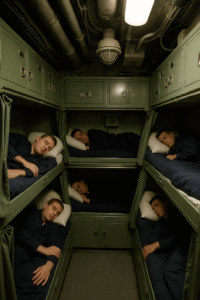Silent Depths of Love

At this very moment, while around 650,000 to 700,000 people are flying thousands of feet above the ground in airplanes, there are also thousands of people deep beneath the sea in submarines. Nuclear submarines are among the most expensive weapons in the world. Their greatest strength lies in their silence. They spend the majority of their lifetime underwater. In this powerful weapon, the most delicate component is its crew. So let’s take a glimpse into the life of those living in this metal capsule.

Steel and Soul
Not everyone can qualify to be part of a submarine crew. The navy has strict requirements, including psychological evaluations. Spending long periods inside a metal tube is no easy task. A single mistake by one person could endanger everyone’s life, so strong nerves are essential. A typical underwater mission is planned for about a month. The public record for the longest duration spent underwater without surfacing is 11 months, set by an American submarine. (At any given time, the U.S. has about 60 to 70 submarines patrolling international waters.) Spending such a long time in a small, enclosed space without sunlight can take a toll on mental health.
Submarathon
How long can a nuclear submarine stay submerged? It entirely depends on the food supply. Its nuclear reactors are fueled only once, and that fuel lasts for the entire lifetime of the submarine. Air and water are regenerated onboard, so food (which is fuel for the crew) is the only limiting factor in how long a submarine can stay submerged on a single mission.
Crew Life
 The crew’s time is divided into three 8-hour shifts: 8 hours of duty, 8 hours of personal time (for reading, exercising, or entertainment), and 8 hours of sleep. Living space is extremely limited, with small coffin-like bunks separated only by thin curtains. There’s virtually no privacy. At any given time, someone is always sleeping, so loud noises, shouting, or slamming doors are strictly prohibited. Typically, there are more crew members than beds, so bunks are shared—used by one person during their shift, then by another during the next.
The crew’s time is divided into three 8-hour shifts: 8 hours of duty, 8 hours of personal time (for reading, exercising, or entertainment), and 8 hours of sleep. Living space is extremely limited, with small coffin-like bunks separated only by thin curtains. There’s virtually no privacy. At any given time, someone is always sleeping, so loud noises, shouting, or slamming doors are strictly prohibited. Typically, there are more crew members than beds, so bunks are shared—used by one person during their shift, then by another during the next.

 The space issue doesn’t stop at beds—it applies to showers and toilets as well. For a crew of over 100, there are only two showers, and each person is allowed only three minutes for bathing. (Submarines filter seawater for bathing use.) There’s only one place for laundry, so clean clothes are considered a luxury. Toilets are used with great care, and waste is collected in a special tank which is emptied at appropriate times. For entertainment, card games, board games, and video games are available, which help in building strong friendships among the crew.
The space issue doesn’t stop at beds—it applies to showers and toilets as well. For a crew of over 100, there are only two showers, and each person is allowed only three minutes for bathing. (Submarines filter seawater for bathing use.) There’s only one place for laundry, so clean clothes are considered a luxury. Toilets are used with great care, and waste is collected in a special tank which is emptied at appropriate times. For entertainment, card games, board games, and video games are available, which help in building strong friendships among the crew.
Interior or Compartment
 The submarine’s engine takes up the most space (about half of the entire submarine). The kitchen comes second. It’s stocked with good, varied food—essential for keeping the crew’s morale up during stressful weeks underwater. Fresh food is available at the start; after that, it’s preserved in cans. Submarines have no internet access, and contact with the outside world is only possible when the sub surfaces—which is very rare. Making contact exposes the submarine’s position, and since stealth is critical, communication is kept minimal. Submarine crew members often go weeks or months without any contact with family or friends. As a result, friendships among the crew become deep and lifelong.
The submarine’s engine takes up the most space (about half of the entire submarine). The kitchen comes second. It’s stocked with good, varied food—essential for keeping the crew’s morale up during stressful weeks underwater. Fresh food is available at the start; after that, it’s preserved in cans. Submarines have no internet access, and contact with the outside world is only possible when the sub surfaces—which is very rare. Making contact exposes the submarine’s position, and since stealth is critical, communication is kept minimal. Submarine crew members often go weeks or months without any contact with family or friends. As a result, friendships among the crew become deep and lifelong.
No Politics Rule on Submarine
There are also some unspoken rules. For instance, controversial topics are avoided—subjects like politics are never discussed. Life on board follows its own traditions and routines. Some standard military rules are relaxed—for example, daily shaving or haircuts are not strictly enforced. But once the mission ends and the crew returns, those rules are reinstated. Life on a submarine is not for everyone. Without fresh air or sunlight, thousands of people at this moment are floating in metal capsules deep under the world’s oceans.
If you like this article, I am sure you will love this one too: The Evolution of Warfare: AI, Ethics and the Irreplaceable Human Role
